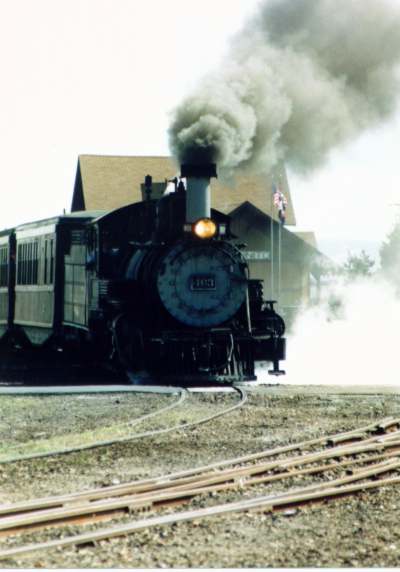Article by Mark H. Hunter
Railroads – June 2003 – Colorado Central Magazine
THE LITTLE TRAIN that “could” still can and will operate again this summer after a winter of discontent that nearly derailed it for good.
The Cumbres & Toltec Scenic Railroad, a historic, coal-fired tourist train that winds through the southern Rocky Mountains from Antonito, Colorado, to Chama, New Mexico, will begin operations on Saturday, June 14 and continue until October 19. The popular narrow-gauge line, which pumps millions of dollars into the economies of both small towns, usually begins operations on Memorial Day weekend, but mechanical problems with its steam-powered locomotives delayed full operations, according to officials.
Trains will originate from Antonito on Sundays and Wednesdays and travel the entire 64-mile distance to Chama, crossing the state line 11 times as it winds from sage-covered prairie up to sub-alpine spruce forests and back down again. On Saturdays and Tuesdays the trips leave from Chama at 10 a.m., and on both trips, visitors return to where they began via busses, according to the railway.
For a while last winter it looked as if the line, which is jointly owned by the states of Colorado and New Mexico, was going to fold. Financial problems plagued the operator, the Rio Grande Railway Preservation Corporation, and mechanical problems plagued the line’s eight steam-powered locomotives which require intensive maintenance.
The line, which annually thrills many thousands of visitors, was closed by Federal Railroad Administration regulators last summer for several weeks due to rail-bed problems and was then shuttered for several more weeks by the U.S. Forest Service due to drought-induced wildfire danger.

The organizational problems were worked out during a series of winter meetings between the C&T’s Commission, an oversight board of elected officials, and the Corporation. The mechanical problems will be solved, officials say, by a late-March grant from New Mexico for $710,000, plus a million-dollar grant from the federal government awarded just a few weeks ago.
The mountains received a moderate blanket of snowfall which reduced the fire danger at least for the early part of the season — but the line may still be closed if the forest dries out in July and August, according to officials.
“We’re delighted the line will be running again,” said Antonito Mayor Rafael Lorenzo Gallegos. “It looks like we’ve all got it together (the commission, corporation, Forest Service and both towns) and we have to continue to work together.”
Jan Reis, president of the Chama Chamber of Commerce, said recently “we suffered hugely last year when it was closed. The railroad is critically important to us for jobs and the trickle-down effect it has on our hotels, restaurants and galleries.”
The railway recently granted ownership of the old, dilapidated and un-used depot to the town of Antonito which they plan to restore to its original condition, Gallegos said. Over the summer, town volunteers and a host of Friends of the Cumbres & Toltec, a 2,000 member non-profit group, plan a series of work days to repair the depot so it can be used by next summer.
The C&T was originally built in 1880 as part of the Rio Grande’s San Juan Extension, which served the silver mining district of the San Juan Mountains in southern Colorado.
It was built as a “narrow gauge” with three feet between the rails, instead of the more common 4′ 8½” that is standard railway gauge. The decline of silver prices, caused by the repeal of the 1893 Sherman Act, made it unprofitable to widen. By the 1960s operations had slowed to a trickle, and the Interstate Commerce Commission granted the Rio Grande’s request to abandon it in 1969, marking the end of commercial steam- powered trains in the United States.
In 1970, however, the states of Colorado and New Mexico purchased the track, structures, nine locomotives and 130 other cars and an “amazing group of volunteers kick-started the railroad in the fall of 1970,” according to Brian Shoup, president and CEO of the Friends.
Now, the line has seen new life breathed into it, Shoup says, thanks to the $1 million grant from the U.S. Commerce Department’s Economic Development Administration awarded in late April, that may be tripled if “matching” funds can be found.
“The promise of $3.3 million over the next three years will enable us to have a stable of five or six reliable, FRA-compliant locomotives,” Shoup reported recently. “This is essential to achieving consistent annual rider-ship levels of 60,000, a volume of business that generates the revenue needed to move us to the next level of development.”
For more information call 1-888-CUMBRES (286-2737) or visit the railroad’s web pages at:
www.cumbrestoltec.com or
www.cumbrestoltec.org
Mark Hunter is an independent journalist who works out of Monte Vista.

